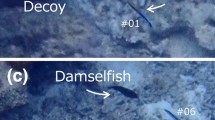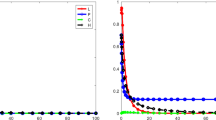Abstract
Diseases, and the parasitic organisms that cause them, can impact aspects of ecosystems ranging from altering food web connectivity to population dynamics. Apart from interspecific interactions, parasites can affect how their hosts behave with conspecifics, such as during competition for resources. Fish are important hosts to a variety of parasite taxa that can, through physical impairment or invasion of sense organs, affect how they interact with conspecifics for food, territory, or mates. In New Zealand, the common bully Gobiomorphus cotidianus plays host to a variety of parasites, encysting throughout the body (Apatemon sp.) or residing within the eyes (Tylodelphys darbyi). We hypothesized that fish with lower levels of infection would secure territories closer to a food patch and be more likely to tolerate sharing that territory. Our experiments show that parasites infecting different areas may have variable impacts on how far the host positions itself from a food patch and the likelihood that it shares its territory. Fish with higher intensities of T. darbyi tended to be closer to the food patch, but Apatemon sp. did not show a similar pattern. Higher infection levels of both parasites were statistically associated with bullies being less likely to share territory. Further, bigger fish were less likely to share their territory at higher intensities infection, and we observed individual variation in a fish’s response between trials. Our findings support that parasites matter in ecological interactions but also emphasize the context dependence of their effects.





Similar content being viewed by others
References
Anderson RM, May RM (1978) Regulation and stability of host-parasite population interactions: I. regulator processes. J Anim Ecol 47:219–247
Barber I, Huntingford FA (1996) Parasite infection alters schooling behaviour: deviant positioning of helminth-infected minnows in conspecific groups. Proc Biol Sci 263:1095–1102
Barber I, Huntingford FA, Crompton DWT (1995) The effect of hunger and cestode parasitism on the shoaling decisions of small freshwater fish. J Fish Biol 47:524–536
Barber I, Ruxton GD (1998) Temporal prey distribution affects the competitive ability of parasitized sticklebacks. Anim Behav 56:1477–1483
Barber I, Hoare D, Krause J (2000) Effects of parasites on fish behaviour: a review and evolutionary perspective. Rev Fish Biol Fish 10:131–165
Barber I, Poulin R (2002) Interactions between fish, parasites, and disease. In: Hart PJB, Reynolds JD (eds) Handbook of Fish Biology and Fisheries. Blackwell Publishing, Oxford, UK, pp 359–389
Barber I, Wright HA (2006) Effects of parasites on fish behaviour: interactions with host physiology. Fish Physiol 24:109–149. https://doi.org/10.1016/S1546-5098(05)24004-9
Barber I (2007) Parasites, behaviour and welfare in fish. App Anim Behav Sci 104:251–264. https://doi.org/10.1016/j.applanim.2006.09.005
Bates D, Maechler M, Bolker B, Walker S (2015) Fitting linear mixed-effects models using lme4. J Stat Softw 67:1–48. https://doi.org/10.18637/jss.v067.i01
Blasco-Costa I, Poulin R, Presswell B (2017) Morphological description and molecular analyses of Tylodelphys sp. (Trematoda: Diplostomidae) newly recorded from the freshwater fish Gobiomorphus cotidianus (common bully) in New Zealand. J Helminthol 91:332–345
Chappell LH (1995) The biology of diplostomatid eyeflukes of fishes. J Helminthol 69:97–101
Chen H, Liu W, Davis AJ, Jordan F, Hwang M, Shao K (2008) Network position of hosts in food webs and their parasite diversity. Oikos 117:1847–1855. https://doi.org/10.1111/j.1600-0706.2008.16607.x
Christensen RHB (2019). ordinal - regression models for ordinal data. R package version 2019.12–10. https://CRAN.R-project.org/package=ordinal. Accessed 25 June 2021
Crowden AE, Broom DM (1980) Effects of the eyefluke, Diplostomum spathaceum, on the behaviour of dace (Leuciscus leuciscus). Anim Behav 28:287–294
Cureton JC II, Martin RE, Lewis RL, Stoops SB, Deaton R (2011) Effects of a trematode infestation on body condition, reproduction and mating behaviors in a livebearing fish. Behaviour 148:967–984
Dobson AP, Hudson PJ (1986) Parasites, disease, and the structure of ecological communities. Trend Ecol Evol 1:11–15
Fredensborg BL, Longoria AN (2012) Increased surfacing behaviour in longnose killifish infected by brain-encysting trematode. J Parasitol 98:899–903. https://doi.org/10.1645/GE-3170.1
Holmes JC, Bethel WM (1972) Modification of intermediate host behaviour by parasites. Zool J Linnaen Soc 51:123–149
Hudson PJ, Dobson AP, Lafferty KD (2006) Is a healthy ecosystem one that is rich in parasites? Trend Ecol Evol 21:381–385
Kalbe M, Kurtz J (2006) Local differences in immunocompetence reflect resistance of sticklebacks against the eye fluke Diplostomum pseudospathaceum. Parasitology 132:105–116
Karvonen A, Seppälä O, Valtonen T (2004) Eye fluke-induced cataract formation in fish: quantitative analysis using an ophthalmological microscope. Parasitology 129:473–478. https://doi.org/10.1017/S0031182004006006
Krause J, Godin JGJ (1994) Shoal choice by banded killifish (emopen Fundulus diaphanusemclose, Teleostei, Cyprinodontidae): Effects of predation risk, fish size, species composition and size of shoals. Ethol 98:12–136
Kuznetsova A, Brockhoff PB, Christensen RHB (2017) lmerTest package: tests in linear mixed effects models. J Stat Softw 82:1–26. https://doi.org/10.18637/jss.v082.i13
Lafferty K, Morris AK (1996) Altered behaviour of parasitized killifish increases susceptibility to predation by bird final hosts. Ecology 77:1390–1397. https://doi.org/10.2307/2265536
Lafferty KD, Shaw JC (2013) Comparing mechanisms of host manipulation across host and parasite taxa. J Exp Biol 216:56–66
Lafferty KD (2008) Ecosystem consequences of fish parasites. J Fish Biol 73:2083–2093
Lafferty KD, Allesina S, Arim M, Briggs CJ, De Leo G, Dobson AP, Dunne JA, Johnson PTJ, Kuris AM, Marcogliese DJ, Martinez ND, Memmott J, Marquet PA, McLaughlin JP, Mordecai EA, Pascual M, Poulin R, Thieltges DW (2008) Parasites in food webs: the ultimate missing links. Ecol Lett 11:533–546
Maan ME, van der Spoel M, Jimenez PQ, van Alphen JJM, Seehausen O (2006) Fitness correlates of male colouration in a Lake Victoria cichlid fish. Behav Ecol 17:691–699
McDowall RM (1990) New Zealand freshwater fishes: a natural history and guide. Heinemann Reed MAF Publishing Group, Auckland, NZ
Mouritsen K (2002) The parasite-induced surfacing behavior in the cockle Austrovenus stutchburyi: a test of an alternative hypothesis and identification of potential mechanisms. Parasitology 124:521–528
Mouritsen K, Poulin R (2003) Parasite-induced trophic facilitation exploited by a non-host predator: a manipulator’s nightmare. Int J Parasitol 33:1043–1050
Muñoz JCV, Staaks G, Knopf K (2017) The eye fluke Tylodelphys clavata affects prey detection and intraspecific competition of European perch (Perca fluviatilis). Parasitol Res 116:2561–2567. https://doi.org/10.1007/s00436-017-5564-1
Muñoz JCV, Bierbach D, Knopf K (2019) Eye fluke (Tylodelphys clavata) infection impairs visual ability and hampers foraging success in European perch. Parasitol Res. https://doi.org/10.1007/s00436-019-06389-5
Owen SF, Barber I, Hart PJB (1993) Low level infection by eye fluke, Diplostomum spp., affects the vision of three-spined sticklebacks, Gasterosteus aculeatus. J Fish Biol 42: 803-806
Poulin R (1993) Age-dependent effects of parasites on anti-predator responses in two New Zealand freshwater fish. Oecologia 96:431–438
Poulin R (2000) Variation in the intraspecific relationship between fish length and intensity of parasitic infection: biological and statistical causes. J Fish Biol 56:123–137. https://doi.org/10.1111/j.1095-8649.2000.tb02090.x
Poulin R (2010) Parasite manipulation of host behaviour: an update on frequently asked questions. In: Brockmann HJ (ed) Advances in the study of behavior. Elsevier Inc., Academic Press, pp 151–186
Presswell B, Blasco-Costa I (2020) Description of Tylodelphys darbyi n. sp. (Trematoda: Diplostomidae) from the threatened Australasian crested grebe (Podiceps cristatus australis, Gould 1844) and linking of its life-cycle stages. J Helminthol 94.https://doi.org/10.1017/S0022149X19000142
Ruehle B, Poulin R (2020) Risky business: influence of eye flukes on use of risky microhabitats and conspicuousness of a fish host. Parasitol Res 119:423–430. https://doi.org/10.1007/s00436-019-06589-z
Scott ME, Dobson A (1989) The role of parasites in regulating host abundance. Parasitol Today 5:176–183
Seppälä O, Karvonen A, Valtonen T (2004) Parasite-induced change in host behaviour and susceptibility to predation in an eye fluke-fish interaction. Anim Behav 68:257–263. https://doi.org/10.1016/j.anbehav.2003.10.021
Seppälä O, Karvonen A, Valtonen T (2005) Manipulation of fish host by eye flukes in relation to cataract formation and parasite infectivity. Anim Behav 70:889–894. https://doi.org/10.1016/j.anbehav.2005.01.020
Seppälä O, Karvonen A, Valtonen T (2008) Shoaling behaviour of fish under parasitism and predation risk. Anim Behav 75:145–150. https://doi.org/10.1016/j.anbehav.2007.04.022
Shirakashi S, Goater CP (2002) Intensity-dependent alteration of minnow (Pimephales promelas) behaviour by a brain-encysting trematode. J Parasitol 88:1071–1074
Sinclair ARE (1979) The eruption of the ruminants. In: Sinclair ARE, Norton-Griffiths M (eds) Serengeti: Dynamics of an ecosystem. University of Chicago Press, Chicago, pp 82–103
Stumbo AD, Poulin R (2016) Possible mechanism of host manipulation resulting from a diel behaviour pattern of eye-dwelling parasites? Parasitology 143:1261–1267. https://doi.org/10.1017/S0031182016000810
Ubels JL, DeJong RJ, Hoolsema B, Wurzberger A, Nguyenm TT, Blankespoor HD, Blankespoor CL (2018) Impairment of retinal function in yellow perch (Perca flavescens) by Diplostomum baeri metacercariae. Int J Parasitol Parasites Wildl 7:171–179
Voutilainen A, Figueiredo K, Huuskonen H (2008) Effects of the eye fluke Diplostomum spathaceum on the energetics and feeding of Arctic charr Salvelinus alpinus. J Fish Biol 73:2228–2237
Voutilainen A, Huuskonen H, Taskinen J (2010) Penetration and migration success of Diplostomum spp. cercariae in Arctic charr. J Parasitol 96:232–235
Wickham H, Averick M, Bryan J, Chang W, McGowan LD, François R, Grolemund G, Hayes A, Henry L, Hester J, Kuhn M, Pedersen TL, Miller E, Bache SM, Müller K, Ooms J, Robinson D, Seidel DP, Spinu V, Takahashi K, Vaughan D, Wilke C, Woo K, Yutani H (2019) Welcome to the tidyverse. J Open Sourc Softw 4:1686. https://doi.org/10.21105/joss.01686
Winemiller KO, Rose KA (1992) Patterns of life-history diversification in North American fishes: implications for population regulation. Can J Fish Aquat Sci 49:2196–2218
Acknowledgements
We would like to thank the members of the Evolutionary and Ecological Parasitology Lab as well as Jolyn Chia for their assistance with field and lab work. We would also like to thank the University of Otago for supporting Brandon Ruehle via a PhD Scholarship.
Author information
Authors and Affiliations
Corresponding author
Ethics declarations
Ethics approval
All applicable international, national, and/or institutional guidelines for the care and use of animals were followed. All procedures performed in studies involving animals were in accordance with the ethical standards of the University of Otago Animal Ethics Committee (No. 70/17001).
Conflict of interest
The authors declare no competing interests.
Additional information
Section Editor: Simonetta Mattiucci
Publisher's note
Springer Nature remains neutral with regard to jurisdictional claims in published maps and institutional affiliations.
Rights and permissions
About this article
Cite this article
Ruehle, B., Poulin, R. Hunger games: foraging behaviour and shelter use in fish under the context-dependent influence of parasitism. Parasitol Res 120, 3681–3692 (2021). https://doi.org/10.1007/s00436-021-07296-4
Received:
Accepted:
Published:
Issue Date:
DOI: https://doi.org/10.1007/s00436-021-07296-4





